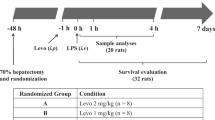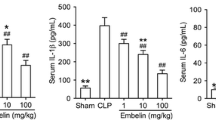Abstract
Objective and design
To examine the protective effects of a lazaroid, 21-aminosteroid U-74389G, in a rat septic shock model.
Materials or subjects
Male Sprague–Dawley rats (n = 60) aged 6–8 months.
Treatment
Groups were exposed to 500 cGy radiation followed by E. coli inoculation, and either placebo or lazaroid injection (10 mg/kg intraperitoneal) 5 days after irradiation.
Methods
Hemodynamic measurements, arterial blood gases, serum lactate, total antioxidative capacity, and cytokine levels were measured at specific time intervals.
Results
Treatment with the lazaroid U-74389G maintained cardiac output and mean aortic pressure. Lazaroid treatment also prevented the increase in serum lactate seen in placebo-treated rats. Cytokine serum levels in lazaroid-treated rats were not significantly different from those in placebo-treated rats at any time point.
Conclusions
Lazaroid treatment of E. coli-inoculated septic animals lessens the hemodynamic deterioration seen in sepsis.



Similar content being viewed by others
References
Angus DC, Linde-Zwirbe WT, Lidicker J, Clermont G, Carcillo J, Pinsky MR. Epidemiology of severe sepsis in the United States: analysis of income, outcome, and associated costs of care. Crit Care Med. 2001;29:1303–10.
Russell JA. Management of sepsis. N Engl J Med. 2006;355:1699–713.
Vincent JL, Abraham E. The last 100 years of sepsis. Am J Respir Crit Care Med. 2006;173:257–63.
Dombrovsky VY, Martin AA, Sunderman J, Paz HL. Rapid increase in hospitalization and mortality rates for severe sepsis in the United States: a trend analysis from 1993 to 2003. Crit Care Med. 2007;35:1244–50.
Zhao W, Richardson JS, Momboourquette WeilJA. An in vitro EPR study of the free-radical scavenging actions of the lazaroid antioxidants U-74500A and U-78517F. Free Radic Biol Med. 1995;19:21–30.
Braughler JM, Pregenzer JF, Chase RL, Duncan LA, Jacobsen EJ, McCall JM. Novel 21-aminosteroids as potent inhibitors of iron-dependent lipid peroxidation. J Biol Chem. 1987;262:10438–40.
Krysztopik RJ, Bentley FR, Spain DA, Wilson MA, Garrison RN. Free radical scavenging by lazaroids improves renal blood flow during sepsis. Surgery. 1996;120:657–62.
Krysztopik RJ, Bentley FR, Spain DA, Wilson MA, Garrison RN. Lazaroid improves intestinal blood flow in the rat during hyperdynamic bacteraemia. Br J Surg. 1997;84:1717–21.
Campo GM, Squadrito F, Altavilla D, Squadrito G, Avenoso A, Canale P, et al. Protection of ischemic and reperfused rat myocardium by the nonglucocorticoid 21-aminosteroid U-74389G, a new inhibitor of lipid peroxidation. J Pharmacol Exp Ther. 1996;277:333–40.
Duguay P, Chen H, Daloze P, Dumont L. Cardioprotective effects of the lazaroid U74389G following cold preservation and transplantation of rat hearts. Transplantation. 1996;61:1023–8.
Perna AM, Liguori P, Bonacchi M, Laino GM, Nediani C, Fiorillo C, et al. Protection of rat heart from ischaemia-reperfusion injury by the 21-aminosteroid U74389G. Pharmacol Res. 1996;34:25–31.
Takahashi T, Takeyoshi I, Hasegawa Y, Koyano T, Yamagishi T, Oshima K, et al. Cardioprotective effects of lazaroid U-74389G on ischemia-reperfusion injury in canine hearts. J Heart Lung Transplant. 1999;18:285–91.
Wang J, Weil MH, Kamohara T, Tang W, Sun S, Klouche K, et al. A lazaroid mitigates postresuscitation myocardial dysfunction. Crit Care Med. 2004;32:553–8.
Lee KY, Sebastien PG, Zar H, Mueller RA, Boysen PG. Increase in rat plasma antioxidant activity after E.coli lipopolysaccharide administration. Yonsei Med J. 2001;42:114–9.
Gonder JC, Laber K. A renewed look at laboratory rodent housing and management. ILAR J. 2007;48(1):29–36. (Review).
Brook I, Walker RI, MacVittie TJ. Effect of antimicrobial therapy on bowel flora and bacterial infection in irradiated mice. Int J Radiat Biol Relat Stud Phys Chem Med. 1988;53(5):709–16.
Fishler M, Cole L, Bond V, Milne W. Therapeutic effect of rat bone marrow injection on rats exposed to lethal whole body X-radiation. Am J Physiol. 1954;177:236–42.
Brook I, MacVittie TJ, Walker RI. Recovery of aerobic and anaerobic bacteria from irradiated mice. Infect Immun. 1984;46(1):270–1.
Madonna GS, Ledney GD, Elliott TB, Brook I, Ulrich JT, Myers KR, Patchen ML, Walker RI. Trehalose dimycolate enhances resistance to infection in neutropenic animals. Infect Immun. 1989;57(8):2495–501.
Elliott TB, Brook I, Stiefel SM. Quantitative study of wound infection in irradiated mice. Int J Radiat Biol. 1990;58(2):341–50.
Griffel MI, Astiz ME, Rackow EC, Weil MH. Effect of mechanical ventilation on systemic oxygen extraction and lactic acidosis during early septic shock in rats. Crit Care Med. 1990;18(1):72–6.
Fang X, Tang W, Sun S, Huang L, Chang YT, Huang Z, Weil MH. Cardiopulmonary resuscitation in a rat model of chronic myocardial ischemia. J Appl Physiol. 2006;101(4):1091–6.
Tseng YM, Lin SK, Hsiao JK, Chen IJ, Lee JH, Wu SH, Tsai LY. Whey protein concentrate promotes the production of glutathione (GSH) by GSH reductase in the PC12 cell line after acute ethanol exposure. Food Chem Toxicol. 2006;44(4):574–8.
Ellrodt AG, Riedinger MS, Kimchi A, Berman DS, Maddahi J, Swan HJ, et al. Left ventricular performance in septic shock: reversible segmental and global abnormalities. Am Heart J. 1985;110:402–9.
Kern KB, Hilwig RW, Rhee KH, Berg RA. Myocardial dysfunction after resuscitation from cardiac arrest: an example of global myocardial stunning. J Am Coll Cardiol. 1996;28:232–40.
Altavilla D, Squadrito F, Campo GM, Squadrito G, Arlotta M, Urna G, Sardella A, et al. The lazaroid, U-74389G, inhibits inducible nitric oxide synthase activity, reverses vascular failure and protects against endotoxin shock. Eur J Pharmacol. 1999;369:49–55.
Gadaletta D, Verma M, Davis JD. Inhibition of neutrophil leukotriene generation by the 21-aminosteroid, U-74389F. J Surg Res. 1994;57:233–7.
Semrad SD, Rose ML, Adams JL. Effect of tirilazad mesylate (U74006F) on eicosanoid and tumor necrosis factor generation in healthy and endotoxemic neonatal calves. Circ Shock. 1993;40:235–341.
Shenkar R, Abraham E. Effects of treatment with the 21-aminosteroid, U74389F, on pulmonary cytokine expression following hemorrhage and resuscitation. Crit Care Med. 1995;23:132–9.
Squadrito F, Altavilla D, Ammendolia L, Squadrito G, Campo GM, Sperandeo A, et al. Improved survival and reversal of endothelial dysfunction by the 21-aminosteroid, U-74389G in splanchnic ischaemia-reperfusion injury in the rat. Br J Pharmacol. 1995;115:395–400.
Altavilla D, Squadrito F, Serrano M, Campo GM, Squadrito G, Arlotta M, et al. Inhibition of tumour necrosis factor and reversal of endotoxin-induced shock by U83836E, a ‘second generation’ lazaroid in rats. Br J Pharmacol. 1998;124:1293–9.
Neviere R, Fauvel H, Chopin C, Formstecher P, Marchetti P. Caspase inhibition prevents cardiac dysfunction and heart apoptosis in a rat model of sepsis. Am J Respir Crit Care Med. 2001;163:218–25.
Acknowledgments
We thank Chi-Huei Chang, Hsin-Hui Tseng, and Yang-Ming Tseng for contributing animal care, linear accelerator operation, and laboratory examinations. The grant was supported by Kaohsiung Veterans General Hospital, VGHKS 95-064.
Author information
Authors and Affiliations
Corresponding author
Additional information
Responsible Editor: Artur Bauhofer.
Rights and permissions
About this article
Cite this article
Chang, YT., Wann, SR., Hsieh, KH. et al. The effects of lazaroid U-74389G in a rat sepsis model. Inflamm. Res. 60, 29–35 (2011). https://doi.org/10.1007/s00011-010-0231-3
Received:
Revised:
Accepted:
Published:
Issue Date:
DOI: https://doi.org/10.1007/s00011-010-0231-3




